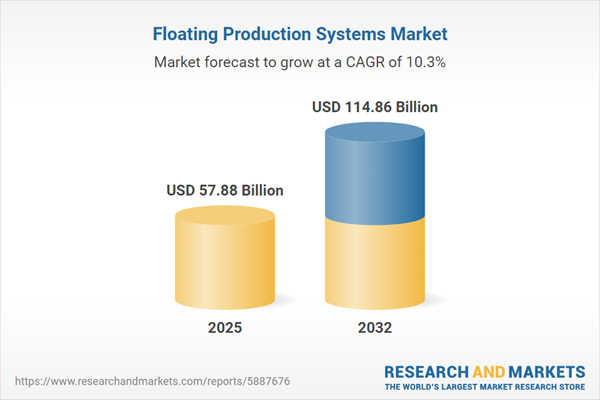Speak directly to the analyst to clarify any post sales queries you may have.
The floating production systems market is experiencing transformative change as operators adapt to shifting regulatory requirements, digital integration, and rising sustainability expectations. Senior decision-makers are prioritizing resilience and flexibility in response to evolving offshore energy demands.
Market Snapshot: Floating Production Systems Market
The floating production systems market is valued at USD 52.36 billion, with expectations to reach USD 57.88 billion within the next year. A compound annual growth rate (CAGR) of 10.31% is set to drive the market to USD 114.86 billion by 2032. Growth stems from diversified global energy portfolios and a shift toward modular offshore solutions. Project operators increasingly deploy agile production platforms to maximize previously inaccessible energy reserves and manage longer asset life cycles. Deployment of advanced subsea technologies, innovative emission reduction measures, and digital monitoring is supporting cost optimization, enhancing operational reliability, and improving global project transparency.
Scope & Segmentation
This market analysis provides strategic clarity for senior leaders by detailing essential segments and innovations shaping floating production systems:
- System Types: Includes FLNG, floating storage and production units, semi-submersible structures, spar platforms, and tension leg platforms. Each system offers distinct lifespans, risk levels, and capacity; the right match supports project sustainability and performance.
- Water Depths: Categorizes applications into deepwater, shallow, and ultra-deepwater, helping guide infrastructure selection and frame project economic models according to environmental and operational parameters.
- Applications: Encompasses upgrades for revitalizing existing assets (brownfield) and next-generation developments (greenfield) leveraging advanced resource management and risk modeling for optimum productivity.
- End Use Streams: Addresses oil and gas integration, specialized gas units, and targeted oil modules, focusing on optimizing throughput and enhancing compression performance within production workflows.
- Hull Materials: Compares steel and concrete options, informing strategy for asset longevity, maintenance planning, and future adaptations to evolving industry standards.
- Mooring Systems: Assesses dynamic positioning, spread mooring, and turret solutions to ensure platform stability and operational flexibility in diverse maritime conditions.
- Regional Focus: Analyses trends in the Americas, Europe, Middle East & Africa, and Asia-Pacific, accounting for regulatory context, investment climate, and workforce expertise necessary for continuous operations.
- Key Companies: Profiles leading players such as MODEC, SBM Offshore, Bumi Armada, BW Offshore, Teekay Offshore, Yinson Holdings, China Oilfield Services, Exmar, Golar LNG, and TechnipFMC, focusing on technology leadership and competitiveness across geographies.
Key Takeaways for Strategic Decision-Makers
- Offshore wind and hydrogen module integration is steadily transforming infrastructure frameworks, aligning with global sustainability priorities and strengthening asset resilience for future demands.
- Adoption of digital analytics, including remote monitoring, supports asset longevity by minimizing operational interruptions and enhancing predictive decision-making across offshore site portfolios.
- Contract models have shifted toward procurement agility, risk sharing, and transparency, helping organizations deliver projects more responsively and manage decommissioning more efficiently.
- Industry-wide collaboration, driven by partnerships among operators, technology firms, and national oil companies, is accelerating the uptake of modular, scalable solutions in regional markets.
- Attention to hull materials and modernization of mooring systems increases safety and reliability, particularly in challenging offshore environments experiencing higher operational demands.
- Regulatory emphasis on local sourcing and supply chain adaptation, notably in Asia-Pacific and West Africa, is reshaping skill sets and ensuring companies keep pace with policy changes.
Tariff Impact on Supply Chains and Procurement
Recent tariff measures in the United States have increased costs for imported steel and advanced subsea components used in offshore production. As a result, many stakeholders are adjusting sourcing approaches, partnering with domestic shipyards, and developing regional expertise. These modifications support supplier diversification, upskilling of the workforce, and investment in fabrication facilities—key considerations for organizations evaluating new floating production system projects and upgrade strategies.
Methodology & Data Sources
The content in this report is based on structured interviews with senior executives, technical experts, and project managers. It is supplemented by comprehensive reviews of industry publications, regulatory data, and peer-reviewed studies, ensuring a reliable and balanced market perspective.
Why This Report Matters for B2B Leaders
- Equips executive teams with actionable insights to anticipate regulatory change, navigate capital market dynamics, and leverage technology evolution in floating production systems.
- Supports competitive benchmarking, risk mitigation, and informed investment choices for senior decision-makers engaging in offshore projects.
- Enhances vendor evaluation and partnership decisions through analysis of supply chain robustness, technology maturity, and viable commercial models for sustained organizational growth.
Conclusion
Floating production systems continue to underpin offshore sector evolution and the energy transition. This report delivers focused, practical guidance to help leaders address shifting market, policy, and technological conditions in the sector.
Additional Product Information:
- Purchase of this report includes 1 year online access with quarterly updates.
- This report can be updated on request. Please contact our Customer Experience team using the Ask a Question widget on our website.
Table of Contents
3. Executive Summary
4. Market Overview
7. Cumulative Impact of Artificial Intelligence 2025
Samples

LOADING...
Companies Mentioned
The key companies profiled in this Floating Production Systems market report include:- MODEC, Inc.
- SBM Offshore N.V.
- Bumi Armada Berhad
- BW Offshore Limited
- Teekay Offshore Partners L.P.
- Yinson Holdings Berhad
- China Oilfield Services Limited
- Exmar NV
- Golar LNG Limited
- TechnipFMC plc
Table Information
| Report Attribute | Details |
|---|---|
| No. of Pages | 199 |
| Published | October 2025 |
| Forecast Period | 2025 - 2032 |
| Estimated Market Value ( USD | $ 57.88 Billion |
| Forecasted Market Value ( USD | $ 114.86 Billion |
| Compound Annual Growth Rate | 10.3% |
| Regions Covered | Global |
| No. of Companies Mentioned | 11 |









